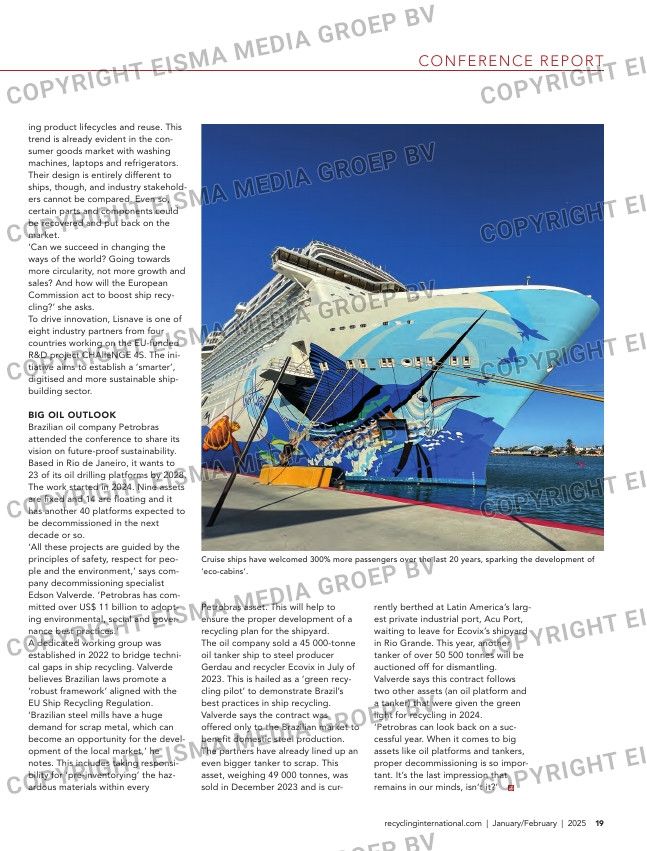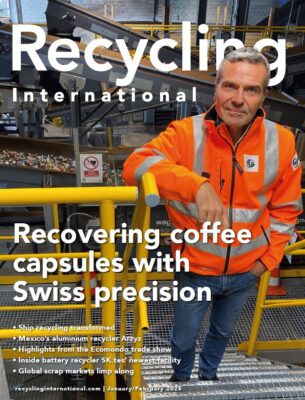Page 19 from: Recycling International Jan/Feb 2025

CONFERENCE REPORT
19recyclinginternational.com | January/February | 2025
smart windows and solar panels, the
structure will be easier to recycle.
Phase two of the project is called
ReCab. This will target dismantling of
the cabin as well as the use of recy-
clable materials and new technologies
such as sensor-based sorting. Cabins
of the future will be modular in
design so they can be repaired easily
and reused, if possible.
‘DE-GROWTH’ PHASE
Portuguese recycler and maintenance
yard Lisnave treats at least four
Panamax-sized vessels annually –
yielding 3 533 tonnes of steel.
The bulk of the steel is transported
via truck, with around 30% moved by
rail. Each vessel typically includes 60
tonnes of hazardous material. Lisnave
has six docks with eight berths each
capable of mooring vessels of 400
metres. The yard is ‘ideally located’
for vessels trading or passing through
Atlantic and Mediterranean waters,
allowing it to be a valuable link in the
chain of green steel production,
according to the company’s environ-
ment manager Cláudia Spranger.
Operations include a pre-treatment
quay and large dry dock. Once the
ship reaches Lisnave, teams work in
tandem across three dedicated lanes:
machinery (mostly non-ferrous); stan-
dard blocks from the midship and
superstructure; and complex blocks
(bow, stem, and engine room).
Spranger agrees with others at the
Lisbon conference that Europe needs
proper installations to comply with
ship recycling regulations. ‘However,
the bureaucracy involved in environ-
mental licensing discourages even the
bravest,’ she argues. For example,
maintenance and repair shipyards,
despite similar activities, experience
great difficulty getting projects
approved because there is no nation-
al solution for ship recycling.
‘Let’s be practical. The existence of
European recycling shipyards empow-
ers Europe. We need an inside solu-
tion for end-of-life vessels. It’s a
must.’
Spranger calls for a period of ‘de-
growth’, with more focus on extend-
ing product lifecycles and reuse. This
trend is already evident in the con-
sumer goods market with washing
machines, laptops and refrigerators.
Their design is entirely different to
ships, though, and industry stakehold-
ers cannot be compared. Even so,
certain parts and components could
be recovered and put back on the
market.
‘Can we succeed in changing the
ways of the world? Going towards
more circularity, not more growth and
sales? And how will the European
Commission act to boost ship recy-
cling?’ she asks.
To drive innovation, Lisnave is one of
eight industry partners from four
countries working on the EU-funded
R&D project CHAlleNGE 4S. The ini-
tiative aims to establish a ‘smarter’,
digitised and more sustainable ship-
building sector.
BIG OIL OUTLOOK
Brazilian oil company Petrobras
attended the conference to share its
vision on future-proof sustainability.
Based in Rio de Janeiro, it wants to
23 of its oil drilling platforms by 2028.
The work started in 2024. Nine assets
are fixed and 14 are floating and it
has another 40 platforms expected to
be decommissioned in the next
decade or so.
‘All these projects are guided by the
principles of safety, respect for peo-
ple and the environment,’ says com-
pany decommissioning specialist
Edson Valverde. ‘Petrobras has com-
mitted over US$ 11 billion to adopt-
ing environmental, social and gover-
nance best practices.’
A dedicated working group was
established in 2022 to bridge techni-
cal gaps in ship recycling. Valverde
believes Brazilian laws promote a
‘robust framework’ aligned with the
EU Ship Recycling Regulation.
‘Brazilian steel mills have a huge
demand for scrap metal, which can
become an opportunity for the devel-
opment of the local market,’ he
notes. This includes taking responsi-
bility for ‘pre-inventorying’ the haz-
ardous materials within every
Petrobras asset. This will help to
ensure the proper development of a
recycling plan for the shipyard.
The oil company sold a 45 000-tonne
oil tanker ship to steel producer
Gerdau and recycler Ecovix in July of
2023. This is hailed as a ‘green recy-
cling pilot’ to demonstrate Brazil’s
best practices in ship recycling.
Valverde says the contract was
offered only to the Brazilian market to
benefit domestic steel production.
The partners have already lined up an
even bigger tanker to scrap. This
asset, weighing 49 000 tonnes, was
sold in December 2023 and is cur-
rently berthed at Latin America’s larg-
est private industrial port, Acu Port,
waiting to leave for Ecovix’s shipyard
in Rio Grande. This year, another
tanker of over 50 500 tonnes will be
auctioned off for dismantling.
Valverde says this contract follows
two other assets (an oil platform and
a tanker) that were given the green
light for recycling in 2024.
‘Petrobras can look back on a suc-
cessful year. When it comes to big
assets like oil platforms and tankers,
proper decommissioning is so impor-
tant. It’s the last impression that
remains in our minds, isn’t it?’
Cruise ships have welcomed 300% more passengers over the last 20 years, sparking the development of
‘eco-cabins’.
16-17-18-19_shiprecycling.indd 19 29-01-2025 11:23



